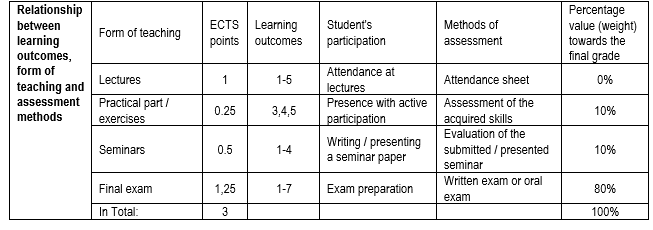Introduce students to different ways of organising primary health care given the cultural and economic moments. Introduce students to primary health care development strategies and encourage them to think critically and scientifically about the advantages and disadvantages of a particular model.
Health promotion
Knowledge of improving health in the community and with the community. Participatory assessment of health needs and use of qualitative analytical approach in assessing health needs of target populations. Health promotion strategies and their effectiveness according to scientifically based indicators.
Primary health care
The concept of primary health care. Basic principles of primary health care. Accessibility. Specific aspects of health care for special groups: pregnant women, children, school children and youth, elderly people, people with special needs, workers …. Analyses and planning in health care. Organisation and management in primary health care. Financial resources, their usage and allocation.
Obavezna literatura:
- Šogorić S. Organizacija zdravstvene zaštite i zdravstvena ekonomika. Zagreb: Medicinska naklada; 2016.
- Kovačić L, ur. Organizacija i upravljanje u zdravstvenoj zaštiti Zagreb: Medicinska naklada; 2004.
- Kalauz S. Organizacija i upravljanje u zdravstvenoj njezi. Zagreb: Medicinska naklada; 2015.
- Šimunić M, Bartolić A. Primarna zdravstvena zaštita. Zagreb: Školska knjiga; 1990.
- Zakon o zdravstvenoj zaštiti RH (važeća zakonska regulativa za PZZ) www.nn.hr
- Zakon o obaveznom zdravstvenom osiguranju i podzakonski akti RH (važeća zakonska regulativa o PZZ) www.hzzo-net.hr
- Health Promotion Conferences - Charters and Declarations. Dostupno na: http://www.who.int/healthpromotion/conferences/en/
- Rootman I, Goodstadt M, Hyndman B, McQueen VD, Potvin L, Springett J, Ziglio E, ur. Evaluation in health promotion: Principles and perspectives. WHO Regional Publications European Series, 2001.
- Saltman R, Rico A, Boerma W, ur. Primary Care in the Driver's Seat? Berkshire, UK: Open University Press & The European Observatory on Health Systems; 2006.
After completing the course, the student will be able to:
1. argue the specifics of the organization of work of various health care activities (ambulance, health care institutions, community health care, health centers, sanatoriums, clinics, hospitals, and others);
2. argue the importance and key points of the need to link health care levels;
3. explain the advantages and importance of self-protection and co-protection on motivation in teaching citizens;
4. show the importance and reasons for connecting health protection and social protection;
5. implement indicators for assessing the state of health of the population;
6. analyze ways to measure the impact of health interventions;
7. rank international health organizations and their functions.



